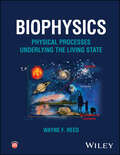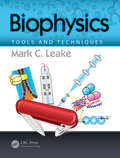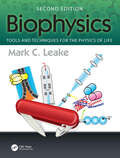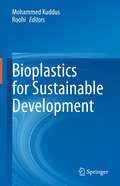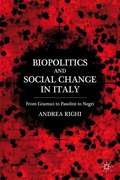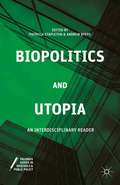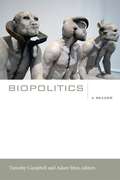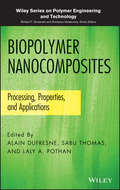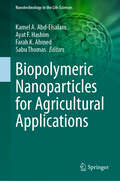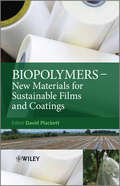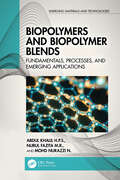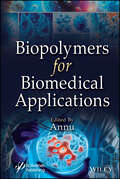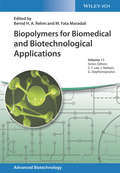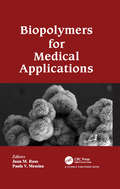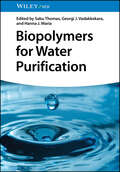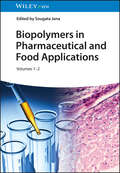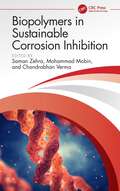- Table View
- List View
Biophysics: Physical Processes Underlying the Living State
by Wayne F. ReedAn introduction to the physics of living organisms The field of biophysics employs the principles of physics to study biological systems, and introduces the concept of the living state. It is a multidisciplinary approach to the study of the living state combining physics, biochemistry, molecular and cell biology, medicine and engineering. The physics of macromolecules and macromolecular assemblies is a particularly important aspect of this broader field. Biophysics: Physical Processes Underlying the living state offers an introduction to the general principles of the living state and their biological applications. Beginning with an historical overview of fundamental scientific theories and fields, the book then provides a brief introduction to cell biology and biochemistry, and then an overview of basic thermodynamics, kinetics, information theory, electrostatics in solution, fluid mechanics and macromolecular physics, and their relationship to the living state. After a presentation of physical methods, with an emphasis on light scattering, different biological macromolecules, selected aspects of their functions, and their physical properties and interactions are surveyed. A brief introduction to vision, biomotion, and theoretical biology is also provided. Exploration of some frontier issues in prebiotic origins of life, consciousness, and astrobiology round out the book. The result is a multifaceted window into the broad and evolving field of biophysics. Biophysics readers will also find: Problems at the conclusion of each chapter to reinforce and focus student knowledgeA gathering of topics in basic physics and physical chemistry which are seldom found in a single source This textbook is suitable for physics and engineering students studying biophysics, macromolecular science, and biophysical chemistry, as well as for polymer scientists, chemists, biochemists, cell and molecular biologists, bioengineers, and others.
Biophysics: Tools and Techniques
by Mark C. LeakeAn Up-to-Date Toolbox for Probing Biology Biophysics: Tools and Techniques covers the experimental and theoretical tools and techniques of biophysics. It addresses the purpose, science, and application of all physical science instrumentation and analysis methods used in current research labs. The book first presents the historical background, concepts, and motivation for using a physical science toolbox to understand biology. It then familiarizes undergraduate students from the physical sciences with essential biological knowledge. The text subsequently focuses on experimental biophysical techniques that primarily detect biological components or measure/control biological forces. The author describes the science and application of key tools used in imaging, detection, general quantitation, and biomolecular interaction studies, which span multiple length and time scales of biological processes both in the test tube and in the living organism. Moving on to theoretical biophysics tools, the book presents computational and analytical mathematical methods for tackling challenging biological questions including exam-style questions at the end of each chapter as well as step-by-step solved exercises. It concludes with a discussion of the future of this exciting field. Future innovators will need to be trained in multidisciplinary science to be successful in industry, academia, and government support agencies. Addressing this challenge, this textbook educates future leaders on the development and application of novel physical science approaches to solve complex problems linked to biological questions. Features: Provides the full, modern physical science toolbox of experimental and analytical techniques, such as bulk ensemble methods, single-molecule tools, and live-cell and test tube methods Incorporates worked examples for the most popular physical science tools, including full diagrams and a summary of the science involved in the application of the tool Reinforces the understanding of key concepts and biological questions A solutions manual is available upon qualifying course adoption.
Biophysics: Tools and Techniques for the Physics of Life
by Mark C. LeakeBiophysics: Tools and Techniques for the Physics of Life covers the experimental, theoretical, and computational tools and techniques of biophysics. It addresses the purpose, science, and application of all physical science instrumentation, theoretical analysis, and biophysical computational methods used in current research labs. The book first presents the historical background, concepts, and motivation for using a physical science toolbox to understand biology. It then familiarizes undergraduate students from the physical sciences with essential biological knowledge. The text subsequently focuses on experimental biophysical techniques that primarily detect biological components or measure/control biological forces. The author describes the science and application of key tools used in imaging, detection, general quantitation, and biomolecular interaction studies, which span multiple length and time scales of biological processes both in the test tube and in the living organism. Moving on to theoretical and computational biophysics tools, the book presents analytical mathematical methods and numerical simulation approaches for tackling challenging biological questions including exam-style questions at the end of each chapter as well as step-by-step solved exercises. It concludes with a discussion of the future of this exciting field. Future innovators will need to be trained in multidisciplinary science to be successful in industry, academia, and government support agencies. Addressing this challenge, this textbook educates future leaders on the development and application of novel physical science approaches to solve complex problems linked to biological questions. Features: Provides the full, modern physical science toolbox of experimental, theoretical, and computational techniques, such as bulk ensemble methods, single-molecule tools, live-cell and test tube methods, pencil-on-paper theory approaches, and simulations. Incorporates worked examples for the most popular physical science tools by providing full diagrams and a summary of the science involved in the application of the tool. Reinforces the understanding of key concepts and biological questions. A solutions manual is available upon qualifying course adoption.
Biophysik der Ernährung: Eine Einführung
by Thomas A. VilgisVerstehen Sie die unzähligen, widersprüchlichen Ernährungsempfehlungen nicht mehr? Können Sie beim Cholesterin nur ganz schwer zwischen Gut und Böse unterscheiden? Verstehen Sie nicht, warum 12 Nüsse pro Tag gut für Ihr Herz und Kreislauf sein sollen? Sind Sie hin- und hergerissen zwischen verschiedenen Ernährungsregeln und Ernährungsformen, die täglich auf Sie hereinprasseln, und verzweifeln am Begriff „gesunde Ernährung“? Oder sind Sie beruflich, z. B. als Berater oder Fitnesscoach, mit Fragen rund um Ernährung konfrontiert und möchten sich die naturwissenschaftlichen Grundlagen aneignen? Der Autor Thomas Vilgis rät, dabei erst einmal gelassen zu bleiben und sachlich über alle Mutmaßungen, Vermutungen, Versprechen, Orientierungsvorschläge nachzudenken.Das Buch führt Sie abseits ausgetretener Pfade und mit naturwissenschaftlicher, nüchterner Sicht an grundsätzliche Fragen der Ernährung heran. Ausgehend von der Ernährungsgeschichte des Homo sapiens begleitet Sie der Autor in das grundlegende Zusammenspiel zwischen Proteinen, Fetten und Kohlenhydraten, was sie im Körper bewirken, wie sie verdaut werden und welche Rolle sie wirklich spielen. So zeigt sich rasch, wie wenig sich hinter manchen zweifelhaften Aussagen verbirgt. Mit dem Anspruch einer ideologiefreien, molekularen Sicht auf die Ernährung gelingt es, auf verständliche und unterhaltsame Weise so manche fragwürdige Empfehlung zur Ernährung zu relativieren und zu entlarven.
Biophysik der Ernährung: Eine Einführung für Studierende, Fachkräfte und Quereinsteiger
by Thomas A. VilgisVerstehen Sie die unzähligen, widersprüchlichen Ernährungsempfehlungen nicht mehr? Können Sie beim Cholesterin nur ganz schwer zwischen Gut und Böse unterscheiden? Sind Sie hin- und hergerissen zwischen verschiedenen Ernährungsregeln und Ernährungsformen, die täglich auf Sie hereinprasseln, und verzweifeln am Begriff „gesunde Ernährung“? Oder sind Sie beruflich, z. B. als Berater oder Fitnesscoach, mit Fragen zum Thema Ernährung konfrontiert und möchten sich die naturwissenschaftlichen Grundlagen aneignen? Der Autor Thomas Vilgis rät, dabei erst einmal gelassen zu bleiben und sachlich über alle Mutmaßungen, Vermutungen, Versprechen und Orientierungsvorschläge nachzudenken.Dieses Buch führt Sie abseits ausgetretener Pfade und mit naturwissenschaftlicher, nüchterner Sicht an grundsätzliche Fragen der Ernährung heran. Ausgehend von der Ernährungsgeschichte des Homo sapiens begleitet Sie der Autor in das grundlegende Zusammenspiel zwischen Proteinen, Fetten und Kohlenhydraten, was sie im Körper bewirken, wie sie verdaut werden und welche Rolle sie wirklich spielen. Unterstützend finden Sie in der zweiten Auflage verschiedene abrufbare Videos, in denen komplexe Zusammenhänge anschaulich erklärt werden. So zeigt sich rasch, wie wenig sich hinter manchen zweifelhaften Aussagen verbirgt. Mit dem Anspruch einer naturwissenschaftlichen und molekularen Sicht auf die Ernährung gelingt es, auf verständliche und unterhaltsame Weise so manche fragwürdige Empfehlung zur Ernährung zu relativieren und einzuordnen.
Biophysik in der Zelle
by Hendrik Dietz Thomas BornschlöglDieses Lehrbuch richtet sich an alle Studierenden der Naturwissenschaften, die einen Einblick in die physikalische Beschreibung grundlegender zellulärer Prozesse suchen. Unter anderem werden die Phänomene der Diffusion und die Mechanik von Makromolekülen behandelt und an vielen Beispielen illustriert. Weiter werden die Bildung der Faserproteine des Zytoskeletts, die mechanischen Eigenschaften der Lipidmembran der Zelle sowie die Enzymkinetik und die Funktionsweise molekularer Motoren besprochen. <P><P> Dieses kompakte Buch baut auf einer zweisemestrigen Vorlesung mit dem Titel Biophysik in der Zelle auf, die an der Technischen Universität München gehalten wird. Um unterschiedliche Herangehensweisen zu unterstreichen und damit verständlicher zu gestalten, werden wichtige Formeln oft auf verschiedenen Wegen hergeleitet. „Übrigens“-Abschnitte, in denen historische oder aktuelle Hintergründe und der wissenschaftliche Zeitgeist der jeweiligen Forschung beleuchtet werden, reichern den Stoff kurzweilig an. Ansprechende, klare und moderne Abbildungen geben dem Buch neben dem fachlich aktuellen und verständlich dargestellten Inhalt einen besonderen Charme.
Biophysik in der Zelle: Für angehende Naturwissenschaftler
by Hendrik Dietz Thomas BornschlöglDieses Lehrbuch richtet sich an alle Studierenden der Naturwissenschaften, die einen Einblick in die physikalische Beschreibung grundlegender zellulärer Prozesse suchen. Unter anderem werden die Phänomene der Diffusion und die Mechanik von Makromolekülen behandelt und an vielen Beispielen illustriert. Weiter werden die Bildung der Faserproteine des Zytoskeletts, die mechanischen Eigenschaften der Lipidmembran der Zelle sowie die Enzymkinetik und die Funktionsweise molekularer Motoren besprochen. Dieses kompakte Buch baut auf einer zweisemestrigen Vorlesung mit dem Titel Biophysik in der Zelle auf, die an der Technischen Universität München gehalten wird. Um unterschiedliche Herangehensweisen zu unterstreichen und damit verständlicher zu gestalten, werden wichtige Formeln oft auf verschiedenen Wegen hergeleitet. „Übrigens“-Abschnitte, in denen historische oder aktuelle Hintergründe und der wissenschaftliche Zeitgeist der jeweiligen Forschung beleuchtet werden, reichern den Stoff kurzweilig an. Ansprechende, klare und moderne Abbildungen geben dem Buch neben dem fachlich aktuellen und verständlich dargestellten Inhalt einen besonderen Charme. Aus dem Inhalt: - Entstehung und Aufbau von Zellen, grundlegende Begriffe der Biophysik und wichtige Grundlagen der Thermodynamik und statistischen Mechanik - Passive Bewegung durch Diffusion: Physikalische Beschreibung der Diffusion, Gittermodelle, Diffusion in einem Potential, biochemische Reaktionen - Mechanik von Balken, Polymeren und Membranen: Elastische Eigenschaften biologischer Bauelemente, Kräfte, Biegen, Dehnen, Strecken und Reißen der Zellmembran und des Zytoskeletts. - Aktive Bewegung und Enzymkinetik: Funktionsweise von Enzymen, molekulare Motoren und die Dynamik der Faserproteine im Zytoskelett
Bioplastics for Sustainable Development
by Mohammed Kuddus RoohiThis book provides the latest information on bioplastics and biodegradable plastics. The initial chapters introduce readers to the various sources and substrates for the synthesis of bioplastics and biodegradable plastics, and explain their general structure, physio-chemical properties and classification.In turn, the book discusses innovative methods for the production of bioplastics at the industrial level and for the microbial production of bioplastics. It highlights the processes that are involved in the conversion of agro-industrial waste into bioplastics, while also summarizing the mechanisms of biodegradation in bioplastics.The book addresses a range of biotechnological applications of bioplastics such as in agriculture, food packaging and pharmaceutical industry, as well as biomedical applications.
Biopolitical Experience
by Claire BlencoweAn original, comprehensive interpretation of Michel Foucault's analysis of biopolitics situating biopolitics in the context of embodied histories of subjectivity, affective investments and structures of experience. Going beyond lamentation at the horrors of biopolitical domination, the book develops a positive-critique of biopolitical experience. "
Biopolitics and Social Change in Italy
by Andrea RighiThe study of how life can be controlled, supported, and manipulated has become the most urgent scientific and political task of our society. By placing the social dimension of labor at the base of the discourse of life, this book engages with the work of key intellectual figures including Gramsci, Pasolini, the neo-feminist militants of Lotta Femminista, Negri, and Virno, and reconstructs a critical genealogy of the notion of biopolitics from the point of view of twentieth and twenty-first century Italy. "
Biopolitics and Utopia: An Interdisciplinary Reader (Palgrave Series in Bioethics and Public Policy)
by Patricia Stapleton Andrew ByersThis interdisciplinary reader offers a fascinating exploration of the intersection of biopolitics and utopia by employing a range of theoretical approaches. Each essay provides a unique application of the two concepts to topics spanning the social sciences and humanities.
Biopolitics: A Reader
by Adam Sitze Timothy CampbellThis anthology collects the texts that defined the concept of biopolitics that has become so significant throughout the humanities and social sciences today. The far-reaching influence of the biopolitical - the relation of politics to life, or the state to the body - is not surprising given its centrality to matters such as healthcare, abortion, immigration, and the global distribution of essential medicines and medical technologies.
Biopolymer Engineering (Synthesis Lectures on Chemical Engineering and Biochemical Engineering)
by Wujie ZhangThis book introduces engineering students and practitioners to biopolymers, which are polymers derived partially or entirely from biobased (renewable) raw materials, and/or are biodegradable. Biopolymers have unique properties such as biocompatibility, making them valuable in diverse industries. Both natural and synthetic biopolymers have been widely used across various fields, including for biomedical, food, and environmental applications. The book explains the fundamentals of biopolymer engineering and how biosynthetic and biochemical pathways enable the design and manufacturing of biopolymers. It then describes their properties and applications in the food industry, biomedicine and environmental engineering. The book can serve as a textbook for engineering students, including those in bioengineering, materials science and engineering, and biochemical engineering, and as a reference for professionals who are looking to refresh their knowledge in the field.
Biopolymer Engineering in Food Processing (Contemporary Food Engineering)
by Vnia Regina Nicoletti TelisDue to their unique properties and ability to interact with other food components, biopolymers have traditionally played a major role in food processing. Biopolymer Engineering in Food Processing explores processing technology associated with biopolymer applications and discusses both operational and economic aspects.Following an overview of biopol
Biopolymer Nanocomposites
by Sabu Thomas Alain Dufresne Laly A. Pothan Domasius Nwabunma Richard F GrossmanSets forth the techniques needed to create a vast array of useful biopolymer nanocompositesInterest in biopolymer nanocomposites is soaring. Not only are they green and sustainable materials, they can also be used to develop a broad range of useful products with special properties, from therapeutics to coatings to packaging materials. With contributions from an international team of leading nanoscientists and materials researchers, this book draws together and reviews the most recent developments and techniques in biopolymer nano-composites. It describes the preparation, processing, properties, and applications of bio- polymer nanocomposites developed from chitin, starch, and cellulose, three renewable resources.Biopolymer Nanocomposites features a logical organization and approach that make it easy for readers to take full advantage of the latest science and technology in designing these materials and developing new products and applications. It begins with a chapter reviewing our current understanding of bionanocomposites. Next, the book covers such topics as:Morphological and thermal investigations of chitin-based nanocompositesApplications of starch nanoparticle and starch-based bionanocompositesSpectroscopic characterization of renewable nanoparticles and their compositesNanocellulosic products and their applicationsProtein-based nanocomposites for food packagingThroughout the book, detailed case studies of industrial applications underscore the unique challenges and opportunities in developing and working with biopolymer nanocomposites. There are also plenty of figures to help readers fully grasp key concepts and techniques.Exploring the full range of applications, Biopolymer Nanocomposites is recommended for researchers in a broad range of industries and disciplines, including biomedical engineering, materials science, physical chemistry, chemical engineering, and polymer science. All readers will learn how to create green, sustainable products and applications using these tremendously versatile materials.
Biopolymeric Nanoparticles for Agricultural Applications (Nanotechnology in the Life Sciences)
by Sabu Thomas Kamel A. Abd-Elsalam Ayat F. Hashim Farah K. AhmedBiopolymers are polymers that are naturally sourced from renewable resources such as plants, animals, and microorganisms. These polymers are gaining increasing attention due to their biodegradability, biocompatibility, and non-toxicity, making them an attractive alternative to traditional synthetic polymers. "Biopolymeric Nanoparticles for Agricultural Applications" focuses on the use of biopolymeric nanoparticles for various agricultural purposes. It explores the potential of these nanoparticles in improving crop productivity, enhancing soil quality, and reducing the environmental impact of agricultural practices. Biopolymeric nanoparticles have gained significant attention in recent years as a promising technology for various agricultural applications such as crop protection, nutrient delivery, and soil remediation. These nanoparticles are typically made from biodegradable and biocompatible materials, such as chitosan, alginate, and starch, and offer several advantages over conventional agricultural formulations including improved stability, controlled release, and enhanced efficacy. This book provides a comprehensive overview of recent advances in the design, synthesis, characterization, and application of biopolymeric nanoparticles in agriculture. It discusses the various biopolymeric nanoparticles that can be utilized in agriculture such as chitosan, cellulose, starch, and protein-based nanoparticles. It delves into their properties, synthesis methods, and characterization techniques. The primary purpose of this book is to provide a comprehensive understanding of the applications of biopolymeric nanoparticles in agriculture. It bridges the gap between the fields of nanotechnology and agriculture, offering insights into the potential benefits and challenges associated with their use.
Biopolymers
by David PlackettAs an area of high topical interest, Biopolymers - New materials for Sustainable Films and Coatings covers the development and utilization of polymers derived from bioresources, with a particular focus on film and coating applications.With growing concern for the environment and the rising price of crude oil, there is increasing demand for non-petroleum-based polymers from renewable resources. Leading research groups worldwide in industry and academe are working on such technology with the objective of applying the latest advances in the field.Written by well-respected experts, this text systematically covers the extraction and production of selected biopolymers as well as their properties and application as films or coatings in a variety of uses. The areas addressed include food packaging, edible coatings, paper coatings and agricultural films.Intended for researchers and students, this book will also be of interest to industry, especially in terms of the practical applications.
Biopolymers and Biopolymer Blends: Fundamentals, Processes, and Emerging Applications (Emerging Materials and Technologies)
by Abdul Khalil H.P.S. Nurul Fazita M. R. Mohd Nurazzi N.Biopolymer and Biopolymer Blends: Fundamentals, Processes, and Emerging Applications showcases the potential of biopolymers as alternative sources to conventional nonbiodegradable petroleum-based polymers. It discusses fundamentals of biopolymers and biopolymer blends from natural and synthetic sources, synthesis, and characterization. It also describes development of desired performance for specific applications in 3D printing and other emerging applications in industry, including packaging, pulp and paper, agriculture, biomedical, and marine. Introduces the fundamentals, synthesis, processing, and structural and functional properties of biopolymers and biopolymer blends Explains the fundamental framework of biopolymer blends in 3D printing, featuring current technologies, printing materials, and commercialization of biopolymers in 3D printing Reviews emerging applications, including active food packaging, electronic, antimicrobial, environmental, and more Discusses current challenges and futures prospects. Providing readers with a detailed overview of the latest advances in the field and a wealth of applications, this work will appeal to researchers in materials science and engineering, biotechnology, and related disciplines.
Biopolymers for Biomedical Applications
by AnnuBiopolymers for Biomedical Applications The twenty chapters written by experts in the field of biopolymers and biomedical engineering, provide a complete resource that systematically discusses the most widely used biopolymers and their biomedical applications, and presents all the important research and developments that have occurred in the field. In recent decades, significant progress has been made in polymer science for biomedical applications. The use of biopolymers specifically attracted the focus on the development of therapeutic polymeric systems. The exclusive features of biopolymers, such as biodegradability and biocompatibility make them highly sought after, and major research conducted with them has resulted in various therapeutic systems. However, until now only a few showed a potential to be appropriate for human use. Each chapter covers a single biopolymer, its properties, and biomedical applications. The chapters are arranged systematically, with the most common biopolymers discussed early in the book to give more insight into the field. Further, a specific chapter is dedicated to the application of biopolymers for wound healing. Later, specific chapters are dedicated to the application of bioplastics and biopolymers for the development of medical devices and biosensors, respectively. Additionally, a chapter is dedicated to the application of biopolymers in the field of dentistry, with a special focus on their risk to human health. Keeping in mind recent advanced technologies, a chapter is dedicated solely to the latest progress of biopolymers in 3D and 4D printing for biomedical applications. The final chapter comprehensively explains the future perspectives of biopolymers in the biomedical field. Audience The book is a reference source for scientists, research scholars, chemical and polymer engineers, biologists, biotechnologists, polymer technologists, industrialists, health experts, and policymakers.
Biopolymers for Biomedical and Biotechnological Applications (Advanced Biotechnology)
by Bernd H. A. RehmThis book highlights the technical and methodological advancements in introducing biopolymers, their study and promoted applications. Organized in four parts, the book provides initially a general overview over biopolymers, properties and biocompatibility and continues with dedicated parts on ?Biopolyemrs through Bioengineering and Biotechnology Venues?, ?Polymeric Biomaterials with wide applications? and ?Biopolymers for Specific Applications?.
Biopolymers for Medical Applications
by Juan M. Ruso Paula V. MessinaThis book presents an experimental and computational account of the applications of biopolymers in the field of medicine. Biopolymers are macromolecules produced by living systems, such as proteins, polypeptides, nucleic acids, and polysaccharides. Their advantages over polymers produced using synthetic chemistry include: diversity, abundance, relatively low cost, and sustainability. This book explains techniques for the production of different biodevices, such as scaffolds, hydrogels, functional nanoparticles, microcapsules, and nanocapsules. Furthermore, developments in nanodrug delivery, gene therapy, and tissue engineering are described.
Biopolymers for Water Purification
by Sabu Thomas Hanna J. Maria Georgi J. VadakkekaraUnderstand the future of water treatment with this groundbreaking introduction There are few more requirements for human life more vital than clean water. Increasingly, however, both developed and developing countries are facing significant challenges to the maintenance of clean water sources, with population growth, industrial pollution, hazardous water contamination, and climate impact all taking a toll. With conventional methods of water purification proving less and less satisfactory, attention is increasingly turning to biopolymers extracted from natural sources, such as cellulose and chitosan, for their potential as renewable water treatment agents. Biopolymers for Water Purification provides an overview of this growing field of study and its recent developments. It covers key techniques for synthesizing and modifying biopolymers, as well as their roles in treating water pollution and meeting targeted water quality requirements. The result is a detailed, comprehensive introduction to this field with potentially immense ramifications for long-term human life. It is the first book solely dedicated to the engineering of biopolymer-based membranes for water purification and promises to become a landmark in the field. Biopolymers for Water Purification readers will also find: Detailed treatment of important polymers including chitin, glycogen, kerating, and more Discussion of ongoing challenges and directions for future research Introduction to the history and characterization of biopolymers Biopolymers for Water Purification is a useful reference for polymer chemists, water chemists, materials scientists, engineering scientists, and advanced postgraduate researchers in any of these or related fields.
Biopolymers in Food Colloids: Thermodynamics and Molecular Interactions
by Maria Germanovna Semenova Eric DickinsonThe theme and contents of this book have assumed a new significance in the light of recent ideas on nanoscience and nanotechnology, which are now beginning to influence developments in food research and food processing. The fabrication of nanoscale structures for food use relies on an in-depth understanding of thermodynamically driven interactions
Biopolymers in Pharmaceutical and Food Applications, 2 Volumes
by Sougata JanaRevolutionize the search for sustainable industry with these biodegradable materials The search for biodegradable materials has become an increasingly essential component of the global response to climate change and the urgent need for more sustainable industrial processes. Biodegradable polymers, either synthetic or natural, have become an explosive research subject as their applications in food, medicinal, and pharmaceutical industries become more and more apparent. There is an urgent need for chemists and other professionals working in these industries to understand the range of available biopolymers and how to use them. Biopolymers in Pharmaceutical and Food Applications presents an overview of all currently-known food-safe polymers and their applications for food and pharmaceutical technology. Its grasp of recent sustainable trends in biopolymer production and distribution make it a one-stop shop for researchers and industry professionals looking to understand the future of sustainable food production, pharmaceutical and cosmetic applications. Comprehensive and accessible, it has never been timelier as a contribution to these key industries. Readers of the two volumes of Biopolymers in Pharmaceutical and Food Applications will also find: Treatment of biopolymers including collagen, chitosan, carrageenan, and more Detailed discussion of drug delivery systems incorporating plant- and animal-based biopolymers An editor with extensive research and teaching experience in biopolymer and pharmaceutical research Biopolymers in Pharmaceutical and Food Applications is ideal for polymer chemists, pharmaceutical chemists, food scientists, and any other researcher looking to work with biodegradable polymers.
Biopolymers in Sustainable Corrosion Inhibition
by Mohammad Mobin Chandrabhan Verma Saman ZehraBiopolymers in Sustainable Corrosion Inhibition covers the fundamentals, properties, and applications of biopolymers and considers their superiorities over traditional alternatives. It explores the synthesis, characterization, inhibition mechanism, and applications of biopolymeric anticorrosive materials.Focusing on environmentally friendly corrosion prevention methods, this book demonstrates how biopolymers slow the corrosion rate and avoid economic losses owing to the metallic corrosion on industrial liners, tools, or surfaces. This book covers the sustainable corrosion inhibition potential of biopolymers and their derivatives, including chitosan, cellulose, chitin, starch, and natural gums.This book will be a valuable reference for undergraduate and graduate students and academic researchers in the fields of biopolymers, corrosion science and engineering, environmental science, chemical engineering, green chemistry, and mechanical/industrial engineering.
